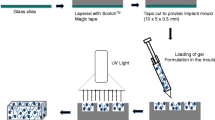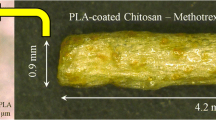Abstract
Etoposide-loaded poly(lactic-co-glycolic acid) implants were developed for intravitreal application. Implants were prepared by a solvent-casting method and characterized in terms of content uniformity, morphology, drug-polymer interaction, stability, and sterility. In vitro drug release was investigated and the implant degradation was monitored by the percent of mass loss. Implants were inserted into the vitreous cavity of rabbits’ eye and the in vivo etoposide release profile was determined. Clinical examination and the Hen Egg Test-Chorioallantoic Membrane (HET-CAM) method were performed to evaluate the implant tolerance. The original chemical structure of the etoposide was preserved after incorporation in the polymeric matrix, which the drug was dispersed uniformly. In vitro, implants promoted sustained release of the drug and approximately 57% of the etoposide was released in 50 days. In vivo, devices released approximately 63% of the loaded drug in 42 days. Ophthalmic examination and HET-CAM assay revealed no evidence of toxic effects of implants. These results tend to show that etoposide-loaded implants could be potentially useful as an intraocular etoposide delivery system in the future.








Similar content being viewed by others
References
Kiss S, Leiderman YI, Mukai S. Diagnosis, classification, and treatment of retinoblastoma. Int Ophthalmol Clin. 2008;48:135–47.
Chantada G, Schaiquevich P. Management of retinoblastoma in children: current status. Pediatr Drugs. 2015;17:185–98.
Eljarrat-Binstock E, Peer J, Domb AJ. New techniques for drug delivery to the posterior eye segment. Pharm Res. 2010;27:530–43.
Anselmo AC, Mitragori S. An overview of clinical and commercial impact of drug delivery systems. J Control Release. 2014;190:15–28.
Kuno N, Fuji S. Biodegradable intraocular therapies for retinal disorders. Drugs Aging. 2010;27:117–34.
Fernandes-Cunha GM, Rezende CMF, Mussel WN, Silva GR, Gomes ECL, Yoshida MI, et al. Anti-toxoplasma activity and impact evaluation of lyophilization, hot molding process, and gamma-irradiation techniques on CLH-PLGA intravitreal implants. J Mater Sci. 2016;27:10. https://doi.org/10.1007/s10856-015-5621-1.
Hande KR. Topoisomerase II inhibitors. Update Cancer Ther 2008; 3: 13–26.
Klasen A, Kessari R, Mercier L, Valade C, Grill J, Desmaris R, et al. Stability of etoposide solutions in disposable infusion devices for day hospital cancer practices. Drugs RD. 2014;14:13–23.
Reif S, Kingreen D, Kloft C, Grimm J, Siegert W, Schunack W, et al. Bioequivalence investigation of high dose etoposide and etoposide phosphate in lymphoma patients. Cancer Chemother Pharmacol. 2001;48:134–40.
Reif S, Nicolson MC, Bisset D, Reid M, Kloft C, Jaehde U, et al. Effect of grapefruit juice intake on etoposide bioavailability. Eur J Clin Pharmacol. 2002;58:491–4.
Mitra M, Dilnawaz F, Misra R, Harilal A, Verma RS, Sahoo SK, et al. Toxicogenomics of nanoparticulate delivery of etoposídeo: potential impact on nanotechnology in retinoblastoma therapy. Cancer Nanotechnol. 2011;2:21–36.
Shah S, Pal A, Gude R, Devi S. A novel approach to prepare etoposide-loaded poly(n-vinyl caprolactam-co-methylmethacrylate) copolymeric nanoparticles and their controlled release studies. J Appl Polym Sci. 2013;127:4991–9.
Patlolla RR, Vobalaboina V. Folate-targeted etoposide-encapsulated lipid nanospheres. J Drug Target. 2008;16:269–75.
Dhanaraju MD, Sathyamoorthy N, Sundar VD, Suresh C. Preparation of poly(epsilon-caprolactone) microspheres containing etoposide by solvent evaporation method. Asian J Pharm Sci. 2010;5:114–22.
Solano AGR, Pereira AFP, Pinto FCH, Ferreira LGR, Barbosa LAO, Fialho SL, et al. Development and evaluation of sustained-release etoposide-loaded poly(ε-caprolactone) implants. AAPS PharmSciTech. 2013;14:890–900.
Saliba JB, Faraco AAG, Yoshida MI, Vasconselos WL, Cunha AS, Mansur HS. Development and characterization of an intraocular biodegradable polymer system containing cyclosporine-A for the treatment of posterior uveitis. Mater Res. 2008;11:207–11.
Patel DH, Patel MP, Patel MM. Formulation and evaluation of drug free ophthalmic films prepared by using various synthetic polymers. J Young Pharm. 2009;1:116–20.
U.S. Pharmacopoeia-National Formulary [USP 39 NF 34]. Volume 1. Rockville, Md: United States Pharmacopeial Convention, Inc; 2016.
Tian L, He H, Tang X. Stability and degradation kinetics of etoposide-loaded parenteral lipid emulsion. J Pharm Sci 2007; 96: 1719–1728.
Shah JC, Chen JR, Chow D. Preformulation study of etoposide: identification of physicochemical characteristics responsible for the low and erratic oral bioavailability of etoposide. Pharm Res. 1995;6:408–12.
Nobrega AM, Alves EN, Presgrave RF, Costa RN, Delgado IF. Determination of eye irritation potential of low-irritant products: comparison of in vitro results with the in vivo Draize rabbit test. Braz Arch Biol Technol. 2012;55:381–8.
Knoll A, Schmidt S, Chapman M, Wiley D, Bulgrin J, Blank J, et al. A comparison of two controlled-release delivery systems for the delivery of amiloride to control angiogenesis. Microvasc Res. 1999;58:1–9.
Thrimawithana TR, Young S, Bunt CR, Green C, Alany RG. Drug delivery to the posterior segment of the eye. Drug Discov Today. 2006;16:270–7.
Mcdonald PF, Lyons JG, Geever LM, Higginbotham CL. In vitro degradation and drug release from polymer blends based on poly(DL-lactide), poly(L-lactide-glycolide) and poly(ε-caprolactone). J Mater Sci. 2010;45:1284–92.
Fouad H, Elsarnagawy T, Almajhdi FN, Khalil KA. Preparation and in vitro thermo mechanical characterization of electrospun PLGA nanofibers for soft and hard tissue replacement. Int J Electrochem Sci. 2013;8:2293–304.
Jasti BR, Du J, Vasavada RC. Characterization of thermal behavior of etoposide. Int J Pharm. 1995;118:161–7.
Kumar P, Wasim P, Chopra M, Chhikara A. Co-delivery of vorinostat and etoposide via disulfide cross-linked biodegradable polymeric nanogels: synthesis, characterization, biodegradation, and anticancer activity. AAPS PharmSciTech. 2017;19:634–47. https://doi.org/10.1208/s12249-017-0863-5.
Carrer H, Cortez J, Frare LM, Costa MB, Bittencourt PRS. Thermal characterization of the bromopride recrystallized from different solvents and at different temperature conditions. J Therm Anal Calorim. 2016;123:927–31.
Cheng Y, Xu W, Chen Z, Wang Z, Huang D. Micronization of etoposide using solution-enhanced dispersion bysupercritical CO2. J Supercrit Fluids. 2016;115:10–6.
Morales JO, Mcconville JT. Manufacture and characterization of mucoadhesive buccal films. Eur J Pharm Biopharm. 2011;77:187–99.
Yadav KS, Sawant KK. Formulation optimization of etoposide loaded PLGA nanoparticles by double factorial design and their evaluation. Curr Drug Deliv. 2010;7:51–64.
Makadia HK, Siegel SJ. Poly lactic-co-glycolic acid (PLGA) as biodegradable controlled drug delivery carrier. Polymers. 2011;3:1377–97.
Fredenberg S, Wahlgren M, Reslow M, Axelsson A. The mechanisms of drug release in poly(lactic-co-glycolic acid)-based drug delivery systems—a review. Int J Pharm. 2011;415:34–52.
Alany RG, Rades T, Nicoll J, Tucker IG, Davies NM. W/O microemulsions for ocular delivery: evaluation of ocular irritation and precorneal retention. J Control Release. 2006;111:145–52.
Vargas A, Zeisser-Labouèbe M, Lange N, Gurny R, Delie F. The chick embryo and its chorioallantoic membrane (CAM) for the in vivo evaluation of drug delivery systems. Adv Drug Deliv Rev. 2007;59:1162–76.
Li XQ, Shang BY, Wang DC, Zhang SH, Wu SY, Zhen YS. Endostar, a modified recombinant human endostatin, exhibits synergistic effects with dexamethasone on angiogenesis and hepatoma growth. Cancer Lett. 2011;301:212–20.
Panigrahy D, Kaipainen A, Butterfield CE, Chaponis DM, Laforme AM, Folkman J, et al. Inhibition of tumor angiogenesis by oral etoposide. Exp Ther Med. 2010;1:739–46.
Avtar R, Tandon D. A mathematical analysis of intravitreal drug transport. Trop J Pharm Res. 2008;7:867–77.
Mendelsohn ME, Abramson DH, Madden T, Tong W, Tran HT, Dunkel IJ. Intraocular concentrations of chemotherapeutic agents after systemic or local administration. Arch Ophthalmol. 1998;116:1209–12.
Mao Y, Wu Z, Yang H, Lin S, Zheng J. Measurement of intraocular concentrations of etoposide after systemic and local administration. Eye Sci. 2004;20:178–80.
Shah HR, Conway RM, Van Quill KR, Madigan MC, Howard SA, Qi J, et al. Beta-lapachone inhibits proliferation and induces apoptosis in retinoblastoma cell lines. Eye. 2008;22:454–60.
Fialho SL, Rêgo MB, Siqueira RC, Jorge R, Haddad A, Rodrigues AL, et al. Safety and pharmacokinetics of an intravitreal biodegradable implant of dexamethasone acetate in rabbit eyes. Curr Eye Res. 2006;31:525–34.
Wolinsky JB, Colson YL, Grinstaff MW. Local drug delivery strategies for cancer treatment: gels, nanoparticles, polymeric films, rods, and wafers. J Control Release. 2012;159:14–26.
Acknowledgements
The authors would like to thank Quiral Química do Brasil S.A., for the etoposide donation, and CNPq, FAPEMIG, and Brazilian Pharmacopoeia, for the financial support.
Author information
Authors and Affiliations
Corresponding author
Ethics declarations
The experiment was approved by the Ethics Committee in Animal Experimentation of the Ezequiel Dias Foundation (Protocol 030/2011).
Rights and permissions
About this article
Cite this article
Solano, A.G.R., de Fátima Pereira, A., de Faria, L.G.A. et al. Etoposide-Loaded Poly(Lactic-co-Glycolic Acid) Intravitreal Implants: In Vitro and In Vivo Evaluation. AAPS PharmSciTech 19, 1652–1661 (2018). https://doi.org/10.1208/s12249-018-0978-3
Received:
Accepted:
Published:
Issue Date:
DOI: https://doi.org/10.1208/s12249-018-0978-3




